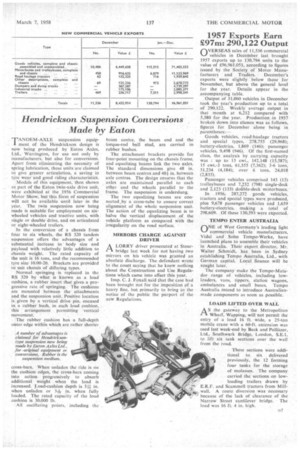Hendrickson Suspension Conversions Made by Eaton
Page 51

If you've noticed an error in this article please click here to report it so we can fix it.
TANDEM-AXLE suspension equipment of the Hendrickson design is now being produced by Eaton Axles, Ltd., Warrington, for use not only by manufacturers, but also for conversions. Apart from eliminating the necessity of spring lubrication, these units are claimed to give greater articulation, a saving in tyre wear and good riding characteristics. Models of this equipment, then shown as part of the Eaton twin-axle drive unit, were exhibited at the 1956 Commercial Motor Show, but this form of suspension will not be available until later in the year. The twin suspension now being made is suitable for employment on sixwheeled vehicles and tractive units, with single or double drive, and on articulated or eight-wheeled trailers. In the conversion of a chassis from four to six wheels, the RS 320 tandem suspension offers the advantages of a substantial increase in body size and payload with relatively little addition to chassis weight. The rated capacity of the unit is 16 tons, and the recommended tyre size 10.00-20. Brackets are provided to suit chassis of differing types. Normal springing is replaced in the RS 320 by what is known as a load cushion, a rubber insert that gives a progressive rate of springing. The cushions are mounted between the attachments and the suspension unit. Positive location is given by a vertical drive pin. encased in a rubber bush, in each load cushion. this arrangement permitting vertical movement. The rubber cushion has a full-depth outer edge within which are rather shorter suspension medium. cross-bars. When unladen the ride is on the cushion edges, the cross-bars coming into action progressively to absorb additional weight when the load is increased. :Load-cushion depth is 3+:1 in. when unladen or 31-6 in. when fully
1 loaded. The rated capacity of the load cushion is 30,000 lb.
All oscillating points, including the beam centre, the beam end and the torque-rod ball stud, are carried in rubber bushes, The attachment brackets provide for four-point mounting on the chassis frame, and equalizing beams link the two axles. The standard dimensions give 48 in. between beam centres and 48+ in. between axle centres. The design ensures that the axles are maintained parallel to each other and the wheels parallel to the frame. The suspension is underslung. The two equalizing beams are connected by a cross-tube to ensure correct alignment of the whole suspension unit. The action of the equalizing beam is to halve the vertical displacement of the vehicle platform as compared with the irregularity on the road surface.
MIRRORS CHARGE AGAINST DRIVER L-1.
A LORRY driver prosecuted at Stour bridge last week for not having two mirrors on his vehicle was granted aa absolute discharge. The defendant wrote to the court saying that he knew nothing about the Construction and Use Regulations which came into effect this year. Insp. C. J. Foxall said that the case had been brought not for the imposition of a heavy fine, but primarily to bring to the notice of the public the purport of the new Regulations.
























































































































